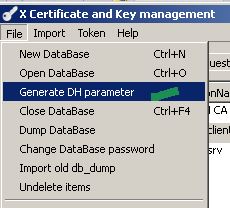Openvpn Easy-rsa Generate Key
Mar 03, 2017 As I'd forgotten how to create a new OpenVPN user, it's not something I do every day, I thought I put here a reminder of the process used. To get a private key and a signed public key the easiest way is to use the Easy-RSA program that came with openvpn. Aug 22, 2016 I tried this by going to /etc/openvpn/easy-rsa and running 'build-key clientname'. I received a message about needing to source vars and.clean-all first. So I ran these commands (knowing that the certificates in the keys folder had already been moved out). Then I tried to generate the client certs again. We will go over using OpenVPN's built-in Easy-RSA scripts that come installed on VyOS by default. This article will not cover how X.509 PKIs work, or how to set up a more secure/better managed PKI, only how to set up a very basic PKI for use with OpenVPN and VyOS specifically. And now to generate the actual certificates, keys, and related.
- Mar 15, 2016 1. Choose a system to act as your CA and create a new PKI and CA:./easyrsa init-pki./easyrsa build-ca 2. On the system that is requesting a certificate, init its own PKI and generate a keypair/request. Note that the init-pki is used only when this is done on a separate system (or at least a separate PKI dir.) This is the recommended procedure.
- Code: Select all 1. Choose a system to act as your CA and create a new PKI and CA:./easyrsa init-pki./easyrsa build-ca 2. On the system that is requesting a certificate, init its own PKI and generate a keypair/request.
Generate OpenVPN certificates and keys for Yeastar S-Series VoIP PBXInfamous second son cd key generator download. and clients.
Important: Commands below are executed in one Command Prompt window.Openvpn Easy-rsa Generate Key Download
If you want to open a new Command Prompt window to execute commands (i.e. create certificates for new client):
- Each time you open a new Command Prompt window, you need to execute
varscommand first, then execute other commands. - You don’t need to execute
init-configcommand, unless you want to edit vars.bat file again.
Initialize the OpenVPN configuration
- Press Windows Key and R key, type
cmdand press Enter key. - Navigate to %ProgramFiles%OpenVPNeasy-rsa (e.g. D:OpenVPNeasy-rsa).
- Initialize the configurations.
- Open the vars.bat file in a text editor.
- Change the
KEY_SIZEsettings.Usually, set the private key size to1024or2048. - Edit the following lines to display your address and company.
Later, when you make CA, certificates and keys, you will be asked to enter information that will be incorporated into your certificate request. If you change the default variables below, you don’t have to enter these information each time.
- Save the vars.bat file and back to Command Prompt window.
- Change the
- Run the following commands, make sure you are operating in a clean environment.CAUTION: This will remove all certificates and keys from the keys directory.
Build Certificate Authority (CA)
- Run the following command to create the ca.crt and ca.key file in the keys directory.
- When prompted to enter information that will be incorporated into your certificate request, enter your country, organization, etc.
Or press the Enter key to use the preset values appeared in brackets.
Important: The only parameter that must be explicitly entered is the Common Name. In the example below, we set Common Name toOpenVPN_CA.
Build certificate and key for server
- Run the following command to create the {server_name}.crt and {server_name}.key file in the keys directory.In the command below, we create server.crt and server.key.
- When prompted to enter information that will be incorporated into your certificate request, enter your country, organization, etc.
Or press the Enter key to use the preset values appeared in brackets.
Important: The only parameter that must be explicitly entered is the Common Name. Enter the same name as{server_name}. In the example below, we set Common Name toserver. - When prompted to sign the certificate and commit, type
yand press the Enter key.
Build certificate and key for client
- Run the following command to create the {client_name}.crt and {client_name}.key file in the keys directory.
In the command below, we create client.crt and client.key.
- When prompted to enter information that will be incorporated into your certificate request, enter your country, organization, etc.
Or press the Enter key to use the preset values appeared in brackets.
Important: The only parameter that must be explicitly entered is the Common Name. Enter the same name as {client_name}. In the example below, we set Common Name toclient. - When prompted to sign the certificate and commit, type
yand press the Enter key. - Repeat steps 1 to 3 to create Certificate & Key for each client respectively.
For each client, choose a name to identify, such as
Windows.crtandWindows.keyfor Windows PC.
Build a ta.key
Run the following command to create ta.key file in the keys directory.
Openvpn Easy Rsa

Generate Openvpn File
